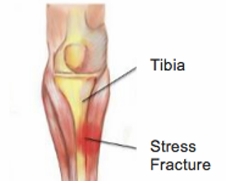
What Is a Stress Fracture?
A stress fracture is a tiny crack in the bone, often too small to show up on a regular X-ray. While it may seem minor at first, if left untreated it can become a more serious break and may even require surgery.
These injuries most commonly affect the lower limbs — especially the hips, shins, and feet — where the bones absorb the most impact during walking, running, or other weight-bearing activities. They’re often caused by overuse, making them common in long-distance runners and people who suddenly increase their activity levels.
Common Symptoms
The pain from a stress fracture usually develops gradually. At first, it may only be noticeable during or just after activity, or even the next morning. If activity continues without rest, the pain typically gets worse, often forcing people to stop exercising altogether.
Stress fractures are more likely to occur in people with lower bone strength — for example, those with osteoporosis. Factors such as low calcium intake, vitamin D deficiency, or a history of inactivity can also increase the risk.
Diagnosis and Treatment
Because stress fractures can mimic other conditions like shin splints, proper diagnosis is important. While they may not appear on an X-ray, scans such as MRI or bone scans can confirm the injury.
The key to healing is resting the affected area so the bone can recover. Most stress fractures take at least six weeks to heal, although some may take longer. Certain areas — like the navicular bone in the foot — have a limited blood supply and may need extra support, such as wearing a boot or cast.
In addition to rest, treatment focuses on addressing the underlying causes, such as:
- Worn-out or unsupportive footwear
- Poor biomechanics
- Muscle weakness that increases strain on the bones
Your physiotherapist can assess your movement patterns, recommend strengthening exercises, and guide you on a safe return to activity.
When to Seek Help
If you suspect you may have a stress fracture or are experiencing persistent pain, it’s important to get it checked early. Early diagnosis and management can prevent more serious injury and get you back to your usual activities sooner.
This information is for general education only and is not a substitute for professional medical advice. Always speak with your physiotherapist or healthcare provider about your specific situation.
